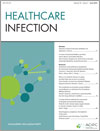
Healthcare Infection
Volume 18 Number 2 2013
Microbial pathogens are becoming increasingly resistant to current drugs. If we can’t treat infection, we should try to prevent it. This article describes the problems we have with current control methods and suggests other ways of keeping us safe from resistant microbes. Reinventing basic hygiene might be the first strategy to explore whilst we prepare for a world without antibiotics.
HI12042 Abstract | HI12042 Full Text | HI12042PDF (219 KB) Open Access Article
HI12059A review of bacterial biofilms and their role in device-associated infection
Many hospital-acquired infections are associated with biofilm infections. In this review article we describe the process of biofilm formation, quorum sensing, and biofilm infection of the healthcare environment, surgical instruments and implantable medical devices. The inability to treat biofilm-infected devices means that therapies targeting biofilm-specific processes and targeting prevention of biofilm formation are required.
HI12043Gentamicin and norfloxacin prophylaxis for transrectal ultrasound-guided prostate biopsy
Infectious complications of trans-rectal ultrasound guided prostate biopsies (TRUSPB) due to failure of antibiotic prophylaxis have been increasingly observed. Antimicrobial resistance in Enterobacteriaceae is likely to account for antibiotic failure. We report a low rate of infectious complications with norfloxacin + gentamicin combination antibiotic prophylaxis, despite rising rates of resistance in Enterobacteriaceae.
HI12044Why is it so hard for doctors to speak up when they see an error occurring?
The ability of doctors to ‘speak up’ when medical error occurs is a cornerstone of patient safety. Our study highlights a steep medical hierarchy, with less than half of the doctors willing to question seniors, even when they noticed an error occurring. The central role of communication on delivering safe and effective healthcare needs further research.
HI12039The combined use of proton pump inhibitors and antibiotics as risk factors for Clostridium difficile infection
There has been an increasing incidence of Clostridium difficile infections (CDI) in the United States. In light of this, this study reviewed the incidence of CDI at a community hospital and the associated use of proton pump inhibitors, antibiotics and both medication concomitantly. Patients on both a proton pump inhibitor and antibiotics were more likely to have CDI, suggesting that both medications should be evaluated in stewardship programs, limiting their use as necessary.
HI13001A study of three methods for assessment of hospital environmental cleaning
The importance of environmental cleaning in preventing the spread of bacteria to other patients in the hospital is increasingly recognised. Our study provided direct comparison of the three most widely used methods in the same patient rooms. Environmental cultures and ATP measurements did show some correlation, highlighting the need for additional comparative studies and evaluation of the cutoffs for ‘clean’ surfaces.
HI12056Hand hygiene compliance: the elephant in the room
Doctors’ hand hygiene compliance is much worse than nurses’ but reasons for this are rarely discussed. The study reported here found that junior medical staff think that what their leader does is more important than what they say when it comes to compliance. Engaging clinical leaders in hand hygiene should be a priority if we hope to improve doctor compliance.
HI12056 Abstract | HI12056 Full Text | HI12056PDF (97 KB) Open Access Article

